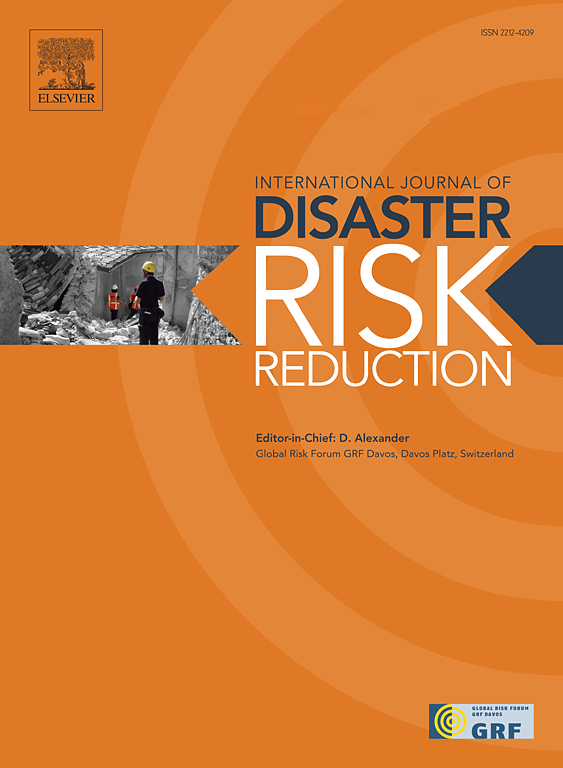European Early Warning Systems for coastal floods: User needs, system availability and pertinent policy and legislation
IF 4.2
1区 地球科学
Q1 GEOSCIENCES, MULTIDISCIPLINARY
International journal of disaster risk reduction
Pub Date : 2025-06-02
DOI:10.1016/j.ijdrr.2025.105602
引用次数: 0
Abstract
The present contribution aims to assess the need for a pan-European Early Warning System (EWS) for coastal floods, and more specifically, to: a) gauge user needs, using a structured questionnaire survey; b) collate the technical specifications of available European EWSs for coastal floods; c) assess the coherence between stated user needs, the specifications of the European EWSs and the existing policy imperatives and legal requirements. The questionnaire survey showed that: the majority (>70 %) of the respondents does not currently use EWSs; most respondents are keen on a pan-European EWS for coastal floods which would include impact assessments as well as event-based flood notifications; and there is a low respondents' familiarity with the relevant international and EU policy and legal frameworks. Regarding the available EWS in Europe, their vast majority provide forecasts/warnings on the basis of Total Water Levels (TWLs) without considering the flood characteristics and impacts; this is inconsistent with both the stated user needs and the policy and legal framework that require risk and impact assessments based on the flood extent, flow depth and velocity. Moreover, there is a ‘polyphony’ in terms of the technical/operational characteristics of the EWSs. Finally, there is an apparent increase in policy and legal requirements for expansion and coherent development of tools for reducing coastal flood risks, including monitoring, assessment, management and the development of integrated EWSs. Generally, there is low coherence between the needs of potential end-users, the characteristics of the available EWSs and the pertinent policy and legislation frameworks.
欧洲沿海洪水预警系统:用户需求、系统可用性和相关政策和立法
目前的贡献旨在评估建立泛欧洲沿海洪水早期预警系统的必要性,更具体地说,是为了:a)利用结构化问卷调查衡量用户的需要;b)整理现有欧洲海岸洪水预警系统的技术规格;c)评估所陈述的用户需求、欧洲电子环境系统规范与现有政策要求和法律要求之间的一致性。问卷调查显示:大多数(> 70%)受访者目前不使用EWSs;大多数受访者都热衷于建立泛欧洲沿海洪水预警系统,其中包括影响评估以及基于事件的洪水通报;受访者对相关国际和欧盟政策和法律框架的熟悉程度较低。就欧洲现有的预警系统而言,它们绝大多数是根据总水位提供预报/预警,而不考虑洪水的特征和影响;这既不符合规定的用户需求,也不符合要求根据洪水范围、水流深度和流速进行风险和影响评估的政策和法律框架。此外,就生态环境系统的技术/操作特点而言,存在“复调”。最后,政策和法律要求明显增加,以扩大和协调发展减少沿海洪水风险的工具,包括监测、评估、管理和综合EWSs的发展。一般来说,潜在最终用户的需要、现有环境信息系统的特点和有关的政策和立法框架之间的一致性很低。
本文章由计算机程序翻译,如有差异,请以英文原文为准。
求助全文
约1分钟内获得全文
求助全文
来源期刊

International journal of disaster risk reduction
GEOSCIENCES, MULTIDISCIPLINARYMETEOROLOGY-METEOROLOGY & ATMOSPHERIC SCIENCES
CiteScore
8.70
自引率
18.00%
发文量
688
审稿时长
79 days
期刊介绍:
The International Journal of Disaster Risk Reduction (IJDRR) is the journal for researchers, policymakers and practitioners across diverse disciplines: earth sciences and their implications; environmental sciences; engineering; urban studies; geography; and the social sciences. IJDRR publishes fundamental and applied research, critical reviews, policy papers and case studies with a particular focus on multi-disciplinary research that aims to reduce the impact of natural, technological, social and intentional disasters. IJDRR stimulates exchange of ideas and knowledge transfer on disaster research, mitigation, adaptation, prevention and risk reduction at all geographical scales: local, national and international.
Key topics:-
-multifaceted disaster and cascading disasters
-the development of disaster risk reduction strategies and techniques
-discussion and development of effective warning and educational systems for risk management at all levels
-disasters associated with climate change
-vulnerability analysis and vulnerability trends
-emerging risks
-resilience against disasters.
The journal particularly encourages papers that approach risk from a multi-disciplinary perspective.
 求助内容:
求助内容: 应助结果提醒方式:
应助结果提醒方式:


